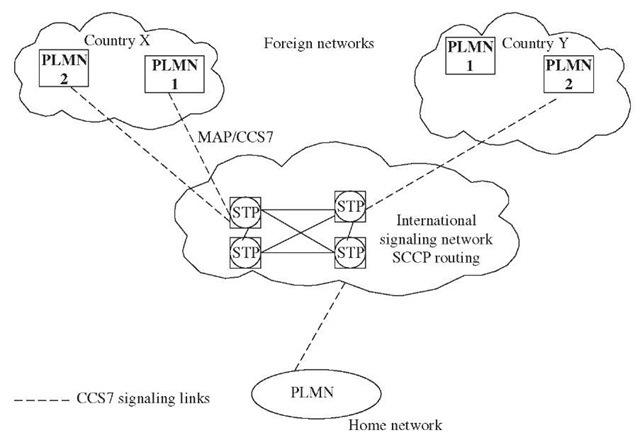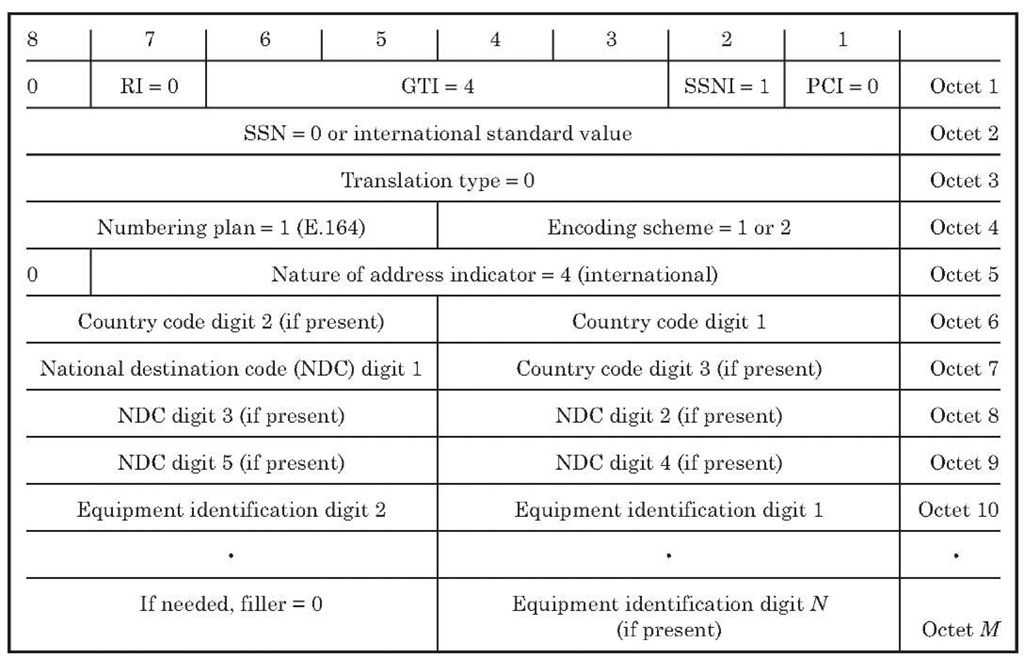A prerequisite for international roaming is connectivity between a Home Public Land Mobile Network (HPLMN) and a Visited Public Mobile Network (VPLMN) for signaling and bearer services, e.g., voice and data.
Figure 6-1 shows that the HPLMN is connected with the VPLMN via the international public switched telephone network (PSTN) for bearer services. This consists of 64-Kbps circuit-switched voice or data links. The signaling required for ISUP calls and also to enable roaming is carried over a logically separate network.
The signaling network carries MAP messages, using SCCP and MTP. An HPLMN and a VPLMN are connected either directly or via an international signaling network. GSM operators normally use an international hub to avoid more expensive point-to-point CCS7 links. However, GSM operators also connect directly to the partner networks that carry heavy roaming traffic, e.g., neighboring countries. GSM operators usually partner with more than one operator in a foreign country to ensure reliability.
The international signaling network consists of SCCP gateways and STPs. It transports MAP signaling messages between PLMNs. An end-to-end partnership agreement must exist between cooperating PLMNs.
Figure 6-2 shows a PLMN in a home country connected to PLMN 1 and 2 of country X and PLMN 2 of country Y. There is no roaming agreement between the PLMN in the home country and the PLMN 1 of country Y.
For international roaming, network nodes in a VPLMN need to communicate with those of a subscriber’s HPLMN. For example, the visited network needs to verify if a foreign subscriber trying to register in its network is authorized and has subscribed to the roaming services.
Figure 6-1 Global roaming network.
Figure 6-2 Inter-PLMN signaling network.
Inter-PLMN addressing
The MAP protocol uses SCCP addressing capabilities to route signaling messages between the VPLMN and the HPLMN nodes across the international network.
The SCCP calling and called party addresses contain the necessary information for the SCCP to route messages between PLMNs. The SCCP message routing is performed using global title (GT) or destination point code (DPC) and subsystem number (SSN). The format and coding of the calling and the called address parameters comply with the SCCP addressing guidelines as defined in ITU-T Q.713 Recommendations. Section 6.1.2 provides a detailed description of the SCCP addressing capabilities.
Address format
The SCCP calling and called party address format for inter-PLMN message routing is illustrated in Figure 6-3.
SCCP called party address (CgPA). The called party address is a variable-length parameter. Its structure is as follows:
■ Point code indicator (PCI) = 0 indicates that the address does not contain a signaling point code.
■ SSN indicator (SSNI) = 1 indicates that MAP SSN is included.
Figure 6-3 Inter-PLMN addressing format.
■ Global title indicator (GTI) = 0100 indicates that the global title includes translation type, numbering plan, encoding scheme, and nature of address indicator. This GTI coding (i.e., 0100) is used for international network applications.
■ Routing indicator = 0 indicates routing is based on global title.
■ The last bit of the octet is reserved for national use and is always set to zero for the international network.
■ Subsystem number (SSN) = 0 or international standard values as given in Table 6-1.
■ For translation type = 0, numbering plan =1, and nature of address indicator = 4, the address is coded according to the following rules for international GT routing.
■ A maximum of the first three digits are used to identify the destination country or region of the addressable entities. For destination countries with only one operator, translation of the country code (CC) is sufficient.
■ For destination countries with multiple network operators, the CC and network destination code (NDC) are translated within the international network to identify the destination.
■ Translation of additional digits (i.e., equipment identification) to identify a specific SCCP user entity is a national matter or network specific.
SCCP calling party address(CdPA). The calling party address is a variable- length parameter. Its structure is the same as the called party address. Figure 6-4 shows a protocol decode for SCCP message routing based on GT. In this example, the VLR in a Hong Kong network is trying to authenticate a roamer (subscriber from China roaming in Hong Kong) by sending a send authentication message to the subscriber’s PLMN HLR. The routing of this message is based on global title.
TABLE 6-1 SSN Identifiers
|
SSN |
Subsystem |
|
0 |
SSN not known |
|
1 |
SCCP management |
|
2 |
Reserved |
|
3 |
ISUP |
|
4 |
OMAP |
|
5 |
MAP |
|
6 |
HLR |
|
7 |
VLR |
|
8 |
MSC |
|
9 |
EIR |
|
10 |
AUC |
|
11 |
SMSC |
Figure 6-4 Example MAP message decode -routing based on ‘GT’





